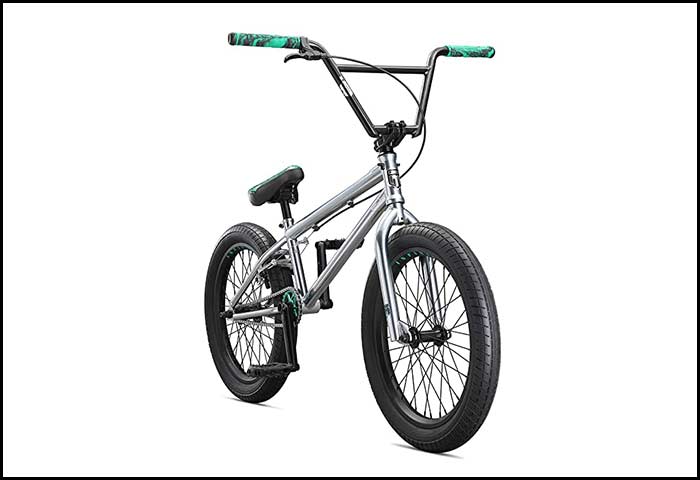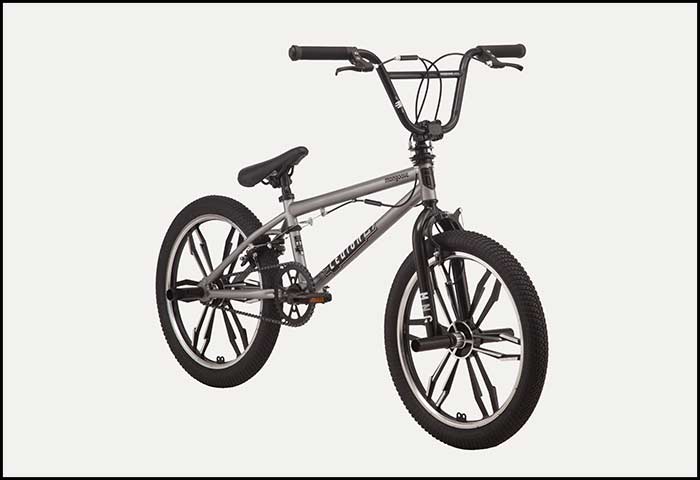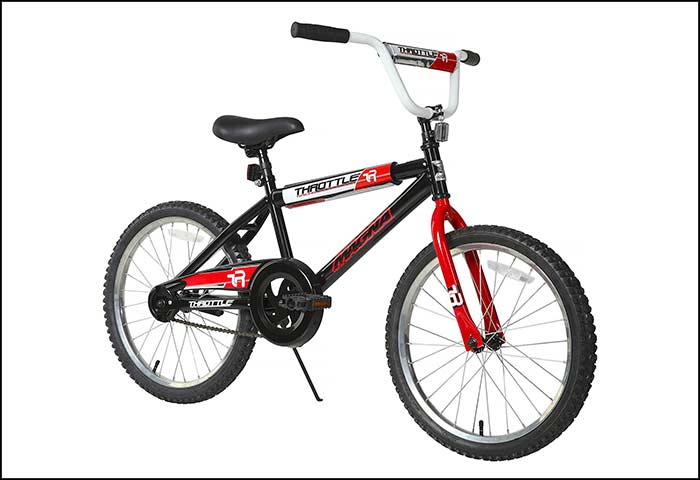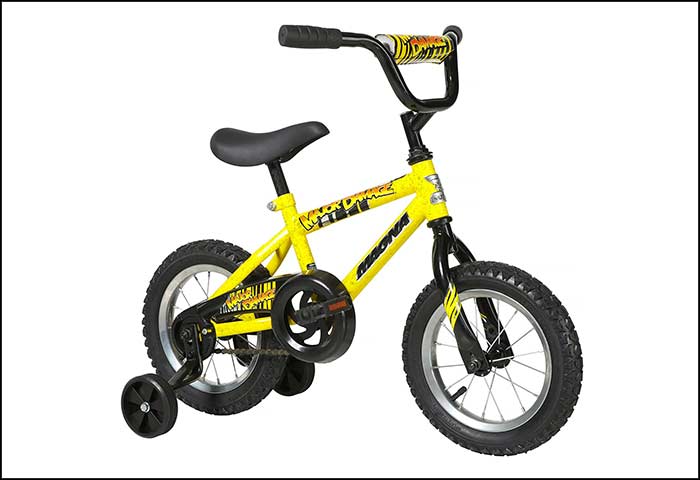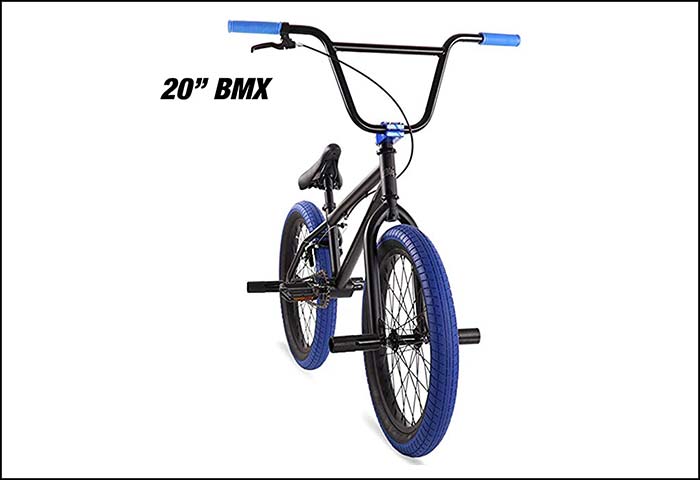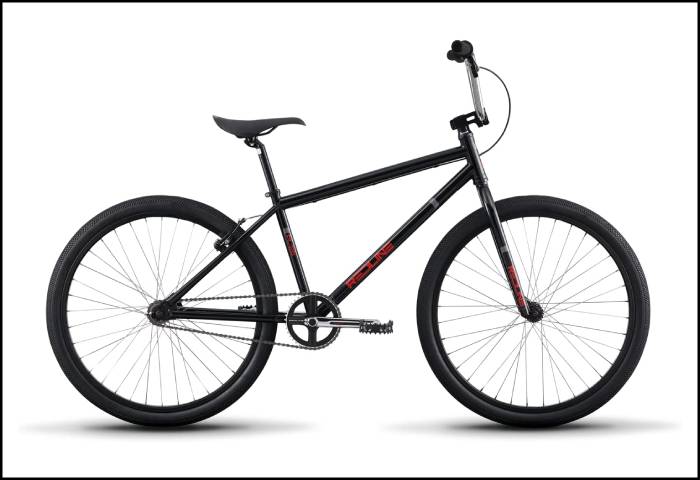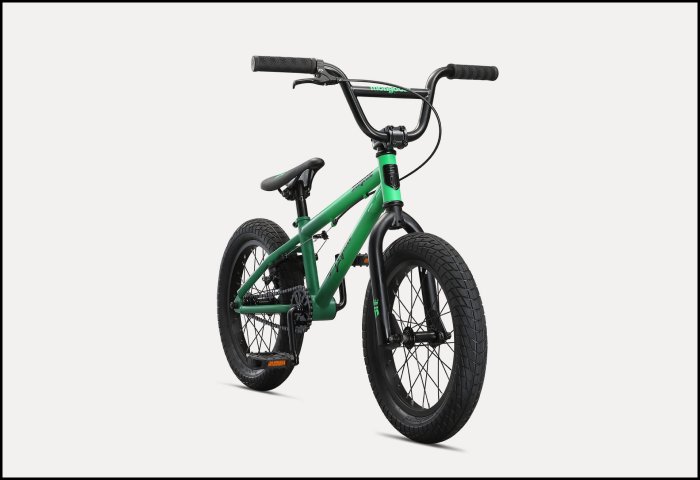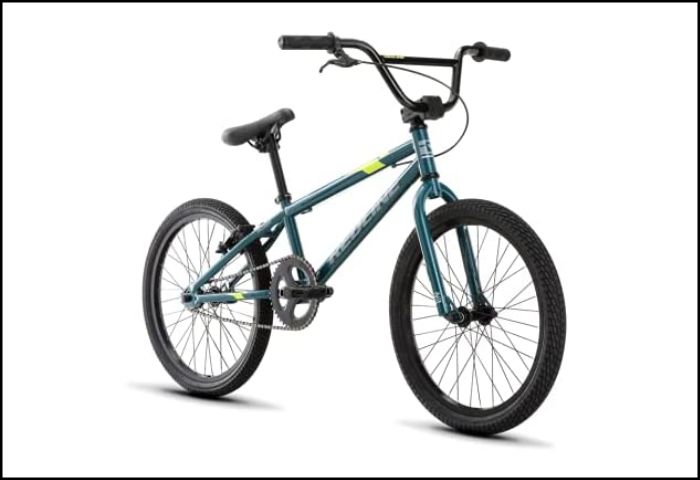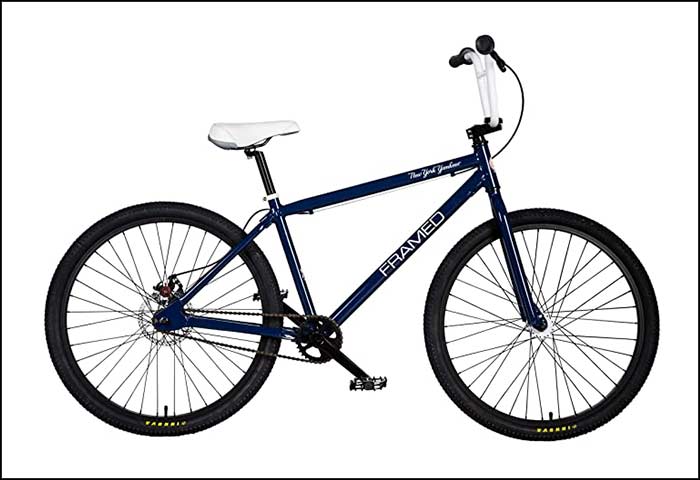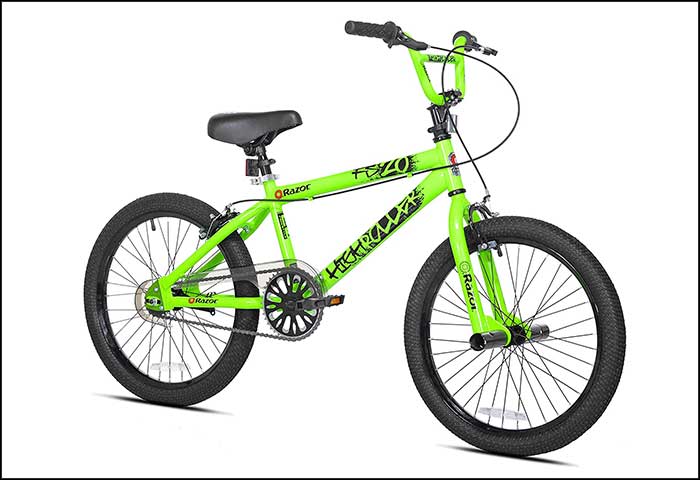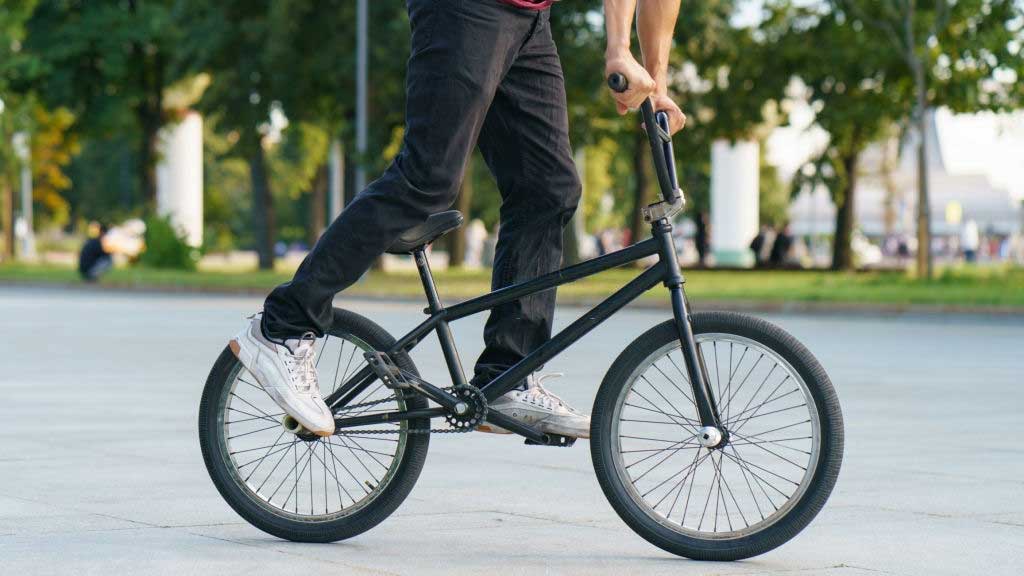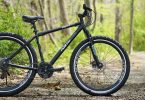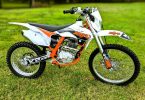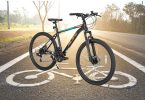Here we’ve thoroughly reviewed the best BMX bikes so you can easily make the right buying decision.
It was August 8th, 1988, and I was 4 years old. My dad was helping me learn to ride my first bike without stabilizers. We were off down the road and I was so pleased with myself. Little did I know, but he had let go.
There I was on my little Blue Bird bike with a box on the back for my things. riding alone. I have never forgotten that exhilarating feeling of freedom as the breeze went through my hair. And I’ve never forgotten the date either: 8/8/88.
I was hooked. But it was a fair few years before I knew about BMX bikes. Perhaps you’re already ahead of me there! 10 years later I tried my friend’s BMX and that was it. It was everything BMX from that moment on.
BMXing has literally changed my life. I’m fitter, more daring, and enjoy life so completely. There’s nothing quite like it. I never thought I would know so much about BMXs! But then, you don’t need encouragement if you’re reading this article. So, let’s get down to it. We’re going to look at the Top 10 best BMX bikes out there on the market today.
Best BMX Bikes Reviews
1 Mongoose Legion L80 Freestyle BMX Bike (Editor’s Choice)
First up is our Editor’s Choice: The Mongoose Legion Freestyle BMX bike. Mongoose has been a popular BMX bike brand for the last 45 years. Their Legion Series is a full range of freestyle BMX bikes for all abilities and ages. This Legion L80 is a fully street, dirt and park-worthy BMX.
It features 8.75” Chromoly 4-piece bars which make the rider stand out from the crowd. The frame, as mentioned, is made from ultra-durable 4130 Chromoly with a top-tube length of 20.75”. It would suit riders of between 5’6” and 6’0”. There are removable brake mounts and a mid BB shell.
The drivetrain has a tubular 3-piece hollow Chromoly spindle cranks measuring 175mm and has a 25T chainring. The tires measure 20” by 2.35” on a single-walled aluminum 36H rim. There’s a 3/8” front hub (with a female axel) and sealed bearing cassette on the rear hub with 9T cog.
The high-tensile steel fork and Chromoly handlebar are joined with a threadless, sealed headset and 50mm stem for the best possible steering performance. As for the brakes, there’s an aluminum U-brake with brake levers providing speed control.
As for its dimensions, it stands at 565mm with a chain stay length of 348mm. The bike comes in eight colors – you have plenty of choice! This bike combines all of these wonderful features and superb craftsmanship for a pretty decent price.
Pros
- A good all-round park, dirt or street BMX
- Not too expensive
- Great bike for beginners
- Features a Chromoly frame
Cons
- Marketed as a beginner to advanced BMX bike crossover
Our Verdict
If you’re eager to find the best BMX bike for beginners, Mongoose Legion Freestyle BMX bike ticks a lot of boxes. The price is reasonable, there are a ton of good features and the reviews are generally good.
If you are just getting into BMXing and want to try out different kinds of freestyle such as street, dirt or park BMX riding, this bike will do all three and generally do it very well too. It is our Editor’s Pick but that does not mean it’s for everyone, especially if you’re an advanced rider.
2 Mongoose Legion Mag Freestyle BMX Bike (For Entry Level)
The Mag Freestyle from the Mongoose Legion range is designed with professional-level performance in mind. It has style as well as strength for riders in the bike park. Made from premium Hi-Ten Steel, the BMX frame and fork offers a responsive and durable ride thanks to low-stance geometry. There are alloy U-brakes at the rear for secure stopping.
The gearing has a hardwearing forged-steel two-piece crank measuring 170mm and is 40x16T for smooth and simply riding. But, the wheels! The 20—inch mag wheels are made from cast aluminum and have sealed bearings. They’re seriously cool. There’s also a cable detangler allowing 360-degree spins of the handlebars. There are four pegs for freestyle grinds and tricks too.
As for its size, the top tube measures 519mm with a stand-over height of 565mm and the length of the chainstay is 365mm. It comes pre-assembled with a limited lifetime warranty.
Pros
- Limited Lifetime Warranty
- 20” Mag wheels
- Cable detangler
- 4 freestyle pegs
Cons
- Difficult assembly
Our Verdict
This is a great little BMX bike with fantastic features and great value for money. If wheels are your thing, then these mag wheels will be right up your street. They’ll be the envy of the bike park.
There’s a limited lifetime warranty too so should there be any issue with it, Mongoose will see that it is fixed! You can spin the handlebars a full 360 and perform stunts on the pegs too. What’s not to love?! Choose your BMX bike wisely, if you’re up for some mind-blowing stunts, have a go with this one.
3 Dynacraft Magna Throttle Boys BMX Street/Dirt Bike (Budget Choice)
The Dynacraft Magna Throttle is marketed as a BMX dirt and street bike. It has an attractive black, red and white 20” frame with the black color emphasized by decals. There are coaster brakes for easy, safe stopping and a tough, durable steel frame.
There is also a kickstand too for easy parking. It is quite small in size and would therefore suit children of between six and ten, with a maximum weight of 105lbs. It measures 35” by 26” by 54”.
The seat is fully adjustable, which is great given that it’s aimed at children in prime growing age! There are reflectors on the front handlebars and the spokes for visibility and safety in lower light. There’s also a crossbar pad too.
One slight niggle of mine, being a female BMX bike rider and having a daughter that’s also into BMX riding, is that this bike is marketed as a “Boy’s” bike. Indeed, the tagline is “Boys Can Ride Fast And Furious On This 20 Inch BMX Style Bicycle.”
Whilst that’s fair enough, it may actually be a little off-putting for the girls out there into BMXing or who want to get into it with this as a first bike. Surely marketing a product as “for boys” is so last century?! But Dynacraft is one of the most well-known BMX brands so you can be sure you’ll get good quality for what you pay.
Pros
- A good first bike for a first foray into BMX bike riding
- Decent Quality for the money
- Lifetime warranty on the fork and the frame
Cons
- Marketed for boys only
- Budget bike
- Difficult assembly
Our Verdict
We have to remember that this is the budget bike category. So, for the money, it is a great little bike. But it is not ideal for adults or for those who are more experienced and are wanting something a little bit more professional.
We believe this is one of the best BMX bikes for kids for its amazing features like reflectors, the adjustable seat and the padding on the handlebars. But it is missing a trick and excluding 50% of the population by labelling it as a boy’s bike, which is way behind the times! Having said that, it does have a lifetime warranty on the fork and the frame.
4 Dynacraft Magna Major Damage Boys BMX Street/Dirt Bike (Choice for Kids)
This striking bike is bright yellow and black and would look great for any daring kid to ride. There is a handlebar pad to protect kids from those inevitable bumps along the road to good BMX riding and there are also the removable training wheels that are adjustable too.
With this bike, there really is no excuse for not giving BMX biking a go! It has a recommended age of between 4 and 8 years and a weight recommendation of up to 81lb, so it’s perfect for getting your little one into BMXing. For clarity, the bike measures 32.5 by 43.75 by 22.25 inches and weighs just over 24lbs.
It has 16” wheels and says it is “perfect for boys looking for a bright BMX frame”. And, whilst we agree, we also think it’s perfect for girls too! It has a matching black saddle and handlebar grips with coaster brakes. The tires are black with silver rims.
Dynacraft states that this kids BMX bike is great to ride around the park, neighborhood or easy trails, making it a great beginner’s dirt or street BMX.
Pros
- Bright, attractive design
- Comes with padded handlebars
- Adjustable and removable training wheels
Cons
- Training wheels are made from weak plastic
Our Verdict
With the added features of training wheels (even if they are plastic) and a padded front bar, this really is a top choice for a kid’s BMX bike. Likewise, the marketing is great for children being a bright yellow and black frame and featuring “Major Damage” decals.
Of course, we’d argue against the marketing ruling out girls for this bike but if your child wants to follow in your footsteps as BMXer (or even if they’re the first in your family!), you could never go wrong with this one.
5 Elite 20” BMX Bicycle The Stealth Freestyle Bike
Perhaps you had a BMX as a kid and have been toying with the idea of taking it one step further. This is where our entry level choice comes in. The Elite 20” Stealth Freestyle BMX bike. This 2019 model is from the Stealth series and works well in the park, street and the dirt tracks.
It comprises a Hi-Tensile steel frame (with a 20” top tube), a Cr-Mo fork, 50mm top-load Alloy stem and an 8.75” handlebar. The brakes are rear cease U-brakes with alloy lever. As for the crank, it’s 170mm of Cr-Mo with American ball bearings and 25 x 9T gearing. The sealed bearing 14mm hub at the rear and its low-profile rims (06061) are surrounded by 20” x 2.5” street tires.
The tires have high-pressure casing, meaning you can use them on the dirt and in the street. There is a micro-knurled surface with a directional tread as well as raised angular tread sections.
The seat is embroidered as well as padded with thick foam and there is a seat clamp included too. All welds are reinforced to help take the impact when doing tricks.
It’s all of this that makes it a great entry level bike. It comes with grinding pegs too. To assemble there are full instructions and it’s easy to yourself if you have the tools or you could take it to a bike store too. Lastly, it is in a great Black Gum color, suitable for anyone!
Pros
- Sleek, black frame design
- Great entry-level BMX
- Comes with easy to follow assembly instructions
- Grinding pegs fitted as standard
Cons
- Some users reported open welds causing a whistling sound when riding.
Our Verdict
If you are wanting to start out into Freestyle BMXing and don’t know where to start when it comes to a bike, this one is a great in-road to the sport. This sturdy little bike has everything that you could need in your first BMX bike, including the pegs! It won’t cost the earth and you can really test out how far you want to go with BMXing before dishing out the dollars on a more expensive, high-spec bike.
6 Redline Bikes PL 26 BMX Race Cruiser
As we explained in our introduction, you can’t race a Freestyle bike, nor can you Freestyle a race BMX bike. Well, you could, but the results wouldn’t be the best! So, now we bring you our best choice for racing, the Redline Bikes PL 26 BMX Race Cruiser.
What you need in a racing bike is a full chromoly frame. And, guess what? This one has it! The chromoly is extremely lightweight meaning you can race at the best possible speed. It is meant to be ridden and ridden well.
There’s updated geometry but retro styling – a truly amazing combination. There are double-walled rims with fully aluminum hubs. There is also a flip-flop hub for anyone who wants to add a rear cog that’s smaller than the one it comes with. Everything about this bike means it’s ready for the race track.
It comes with Tioga Powerblock tires measuring 26” x 2.10” and Tektro 930AL Linear brakes. It is a stunning blue design with retro decals, you will really look the part with this racing BMX bike.
The seat is a harder variety without a cover or padding, which some users weren’t keen on. Our simple answer, though, is don’t sit down if it bothers you! Some users also reported that the sprocket adapters were not deep enough so you may wish to get some deeper ones.
Pros
- Full chromoly frame
- Vintage look
- Great for racing
Cons
- Hard seat
- Shallow sprocket adaptors
Our Verdict
If you want a racing BMX bike that is light and easy to maneuver yet durable and reliable then the Redline Race Cruiser is for you. The frame, being made from full chromoly is extremely lightweight that allows you to ride at the fastest possible speed. However, the seat is not the most comfortable, but then again, this depends on your racing style and how often you want to sit down!
7 Mongoose Legion L16 Freestyle BMX Bike Line for Kids
Another Mongoose BMX features in our best BMX bike reviews. Coming in an array of colors, this kid’s bike has a Hi-Tensile Steel Frame and a Micro-Drive 25 x 9T gearing. There are also multiple choices for the wheel sizes, with it coming in 16”, 18” and 20” wheel sizes. This is what makes this bike a great choice for growing children! But for the purpose of this review, we will look at the L16, the Legion 16” wheeler in bright orange.
The top tube measures 15.3” and is perfect for little kids to give them a true taste of what BMX bike riding is all about. Mongoose suggests that the ideal rider for this size bike is no taller than 3’6”, so you can see it is ideal for little ones.
There’s a 1-piece crank measuring 130mm with a 25T chainring with an American loose ball bearing bottom bracket. The tires are 2.3” in width and are set on single-walled aluminum 28H rims and 3/8” female axle front hub. There’s a 9T sealed bearing in the rear hub cassette too.
As for the brakes, they are aluminum U-brakes offering precise control of speed. There is a 40mm stem connecting the Hi-Ten steel handlebar and fork.
All in all, this bright orange bike is as eye-catching as it is popular. Any BMX kid would be thrilled to have it.
Pros
- Excellent reviews
- Great size for children
Cons
- Users reported that the brake is weak, and it is hard for children to get the bike to stop
Our Verdict
If it is a bright kid’s BMX you’re after and your little one is still on the small size, then this would make a great choice. With 16” wheels it really is a good ride for kids. Additionally, its bright orange design is attractive, yet it also comes in lots of other colors too – even pink! Having said that, some users have said that the brakes are difficult for little ones to use, which could be a problem!
8 Redline Bikes Roam 20 Youth BMX
Redline has done a good job in this Roam model. We liked it’s aggressive race-inspired geometry sustained by a solid frame that is made from high-tensile steel. It packs taller handlebars that allows absolutely spot on maneuverability.
Its freewheel design is an upgrade for those coming from coaster bikes. The rust-free 20-inch alloy wheels are something you can depend on every time you do a stunt, it also supports the main frame in the most reliable way.
It features a durable bottom bracket (American style) and pedals are included with the main frame. Tell you what, kids will love its sporty graphics and the look of its tires (Kendra Kontact)
Pros
- Durable Redline steel frame and fork
- Sturdy aluminum rims
- Tires grips ok
- Good braking ability
Cons
- Doesn’t offer much for pro bikers
Our Verdict
Redline is popular among the kids for its amazing build quality and controlling. The tires’ grip is reliable and breaking is spot on. You can apply all your stunts on this one. It comes semi-installed, so you’d be needing help assembling. Apart from that, it’s a superb option if you consider the price point.
9 Framed x MLB Yankees Twenty6er
With a top tube of 23.5”, this cruiser bike is the perfect choice for comfortable and smooth riding if you are an intermediate rider. Being longer the top tube can provide sufficient stability and control when riding. We rode over 50 miles to fully utilize its potentials and it did live up to our expectations.
It is built to last all-season BMXing too. The three-piece crank set is durable and strong and is ideal for the more aggressive rider who is venturing from beginner to intermediate to advanced.
We were happy with its Avidd BB7 mechanical disc brake’s performance. It worked reliably in most weather conditions. The stopping has been improved in this model.
The chromoly Hi-Ten steel handlebar is lightweight and provides trusting control over your steering and it includes the grips so that you don’t lose grip. This handlebar can withstand impact. The 6061 grade alloy blue frame complements the 26er wheels in a way that maximizes balance. The front triangle is made from chromoly and the Hi-Tensile steel is in the rear, giving the rider a durable and lightweight combination for years of ripping to come.
The company recommends seeking a professional bike mechanic for its assembling. It will save time and mitigate potential safety risks. It’ll also help you avoid any unnecessary repairs too. A bike mechanic will check the bearings and wheels, tensioning the drivetrain correctly in the process.
The unsealed bearings in both the bottom bracket and headset will ensure that your rotation is always smooth. The velo mushroom handle grips measure 150mm with framed alloy lever.
Pros
- Suitable for most freestyle uses
- Good braking
- Sturdy build quality
Cons
- Does not come with pegs
Our Verdict
This bike is well-suited to a rider that has mastered the basics of BMX riding but is looking for something a little bit more than a beginner’s bike. If you’re wanting to master some more tricks and cover some more ground on your BMX, then this durable and lightweight combination will tick a lot of boxes for you.
10 Razor High Roller BMX/Freestyle Bike
This bike scraped into our top 10 as a worthy contender for a Freestyle BMX bike. The black and green frame is made from Hi-Tensile steel and has a 4-bolt stem. There are front and rear brakes and front wheel pegs too for all your tricks and stunts. The seat post clamp is quick release, meaning you can adjust the seat as and when you need to.
The price is pleasing given the features that it comes with, some of which are usually found on the higher-end bikes. The wheels have beefy tires with street tread and 36 spokes, and it is equipped with a rear-side pull handbrake.
It really is a striking bike with its bright green trims and shiny black frame. Few complained about the quality of the brakes but this is a children’s bike and, as far as cheap BMX bikes go, you get what you pay for.
Pros
- Cheap BMX bike
- Attractive design
Cons
- Issues with the brakes
Our Verdict
If you are looking for a cheap kid’s BMX then this would be a good choice for the money. Sure, it has lower ratings than some of the others in our list, but it also has a lower price to go with it. Of course, everyone wants the best bike for their money. But for the money, this is not a bad bike. If you can afford a more expensive one, then go for it. If not, this most certainly fits the budget category well.
What Is Meant by BMX?
Before we delve into the depths of the review, let’s look at what a BMX is exactly and how it differs from a regular bike.
BMX bikes first came on the scene in early 1970s America. They were originally designed as a way for young kids to step into motocross, but it quickly became a sport all of its own.
In fact, BMX is short for ‘Bicycle Motocross’. It went over to Britain almost a decade later as the manufacturers cottoned on to producing ready-made BMX bikes as starter model bikes for youngsters. Their compactness and simplicity are what made them surge in the market.
BMX bikes typically have 20” wheels although other sizes do exist on racing BMXs. The bikes have a rigid fork and frame with high-rise handlebars and only one cassette gear. It’s this simple construction that makes them strong and easy to understand and maintain.
BMX as a sport has two different types: freestyle and racing. BMXing first began with the racing side of things and freestyle came along later as a new group of riders began to specialize in bike handling and doing tricks rather than concentrating on speed. But both types of BMXing offer great fun!
Best BMX Bikes [A Comprehensive Buying Guide]
So, what is it that you should be looking for and considering when buying a BMX bike? Let’s take a look.
Firstly, you need to decide what type of BMX bike you need. Do you want a racing true BMX or a freestyle bike? What about street/jumping/dirt/park BMX? Have you heard of a flatland BMX?
1. Race BMX bikes
As the name suggestions, these are designed with acceleration and speed in mind, so they are often lighter and have different geometry in order to ensure that they are both nimble and stable at high speed. Race BMX bikes are usually unsuitable for Freestyle BMXing, regardless of the sub-type.
2. Freestyle BMX bikes
Freestyle BMXs are designed with stunts in mind and are strong enough to withstand repeated stress such as at skate parks and dirt jumps. The wheels, components and frame materials are equally optimized for maneuverability and strength alike. You can easily manual on a BMX bike if you have any of the Freestyle BMXs.
Freestyle bikes have many sub-divisions which come under the freestyle type. Apart from flatland, the different disciplines have a crossover of features and so an all-rounder freestyle bike is often a good and versatile choice.
- Park: Park BMX riding means riding in a skate park. Despite their name, skateparks are often visited by BMX bikers nearly as much as skaters themselves. Park BMXing also includes using indoor rider parks that are specifically for BMXing. These parks are commonly known as ‘ramps.’
- Dirt Jumping/Trails: This type of BMXing happens on specially built dirt berms and jumps. Riders try to get big air as well as link up their jumps and perform tricks.
- Street: Street riders are creative BMXers, using urban features and infrastructure to perform tricks and turns such as on rails and stairs. Riders are always seeking new good places to try their tricks.
- Flatland BMX: This is rather a nice type of BMXing. With flatland, there aren’t any external features and the rider performs tricks with the bike alone. It has even been nicknamed as ‘BMX breakdancing.’ The rider balances and pivots the bike on hard, flat surfaces.
3. Basic BMX Components
When looking at the parts that make up a BMX bike you need to consider elements like the frame, the forks, the handlebars, the headset, the brakes, bearings (and whether they are unsealed or sealed), the bars and stem, the gears and speed, the pedals, the materials, and the wheels, rims and tires.
Materials
Most starting race BMXs and freestyle BMX bikes have a predominantly steel composition which is called ‘chromo’ (short for Chromoly 4130). This material provides real strength as it is an alloyed steel, especially in comparison to cheaper steels (‘hi-tensile’) that are usually found in lower end bikes such as those found in department stores.
Chromo can be ‘butted’, which means it is possible to make it lighter and thinner on the inside of the tubes as well as reinforced at the joins and ends for added strength.
The best choice material for BMX bikes is steel thanks to it being highly resistant and easy to repair. This is important given the battering that these bikes can take! Steel also gives more compliance when riding which is more comfortable for the rider as there is reduced pressure on their body.
For racing with a BMX, people prefer the lightweight, stiffer frame and therefore aluminum is what most racing BMX bikes are made from. However, serious riders who want an added edge on their race-mates choose carbon fiber frames as the weight is even more reduced and the vibrations are also reduced in comparison with aluminum.
Size
Usually, Freestyle BMXers incorporate both kids, adolescents and adults too, although the size of the wheels is similar across the bikes, the size of the frame can be subtly different to suit the rider’s height and riding style.
The majority of freestyle BMX bikes bought in stores come with a top tube that’s 21” meaning riders can swing the bike beneath them if they are performing tricks that are airborne. The seat stays are often shorter too so that they are easy to whip underneath.
A flatland BMX frame is usually an exception to this as they are often lighter with shorter tubing so that it’s easier to control and balance. The head angle is also much steeper and there are 3/8” dropouts for the smaller axles at the rear.
Racing BMXs have a longer wheelbase and a head angle that is slacker, putting the rider further toward the back of the bike. This offers better handling and stability at speed. There is also a larger range of frame sizes to suit the different ages of BMX racers.
Wheels
Usually, BMX wheels measure 20” as standard. This is much smaller than the wheels of a road bike or a mountain bike. Smaller wheels are usually seen on children’s bikes and larger on ‘trail’ BMXs used in dirt jumping. As a general rule, you can assume that most BMX bikes will have 20” wheels.
Racing BMX bikes usually have two different wheel sizes. The standard 20” wheel diameter, as mentioned above, and the second size of 24”, which is also known as a ‘cruiser’ size. Cruiser BMX bikes give more stability and are more popular for older or taller riders. The wheels in racer BMX bikes are lighter due to them needing to be quick out of the starting gates.
Rims
Rim widths on freestyle BMX bikes come in at 32mm as standard. Riders who put in more hard-hits to the wheels can choose 36mm rims. The rims are aluminum and can have different numbers of layers to provide more support structurally. However, they also add more weight. A standard ideal for most riders is a double walled rim as this is a nice balance between the weight and the strength.
Tires
Tires are the contact point of the ride and the choice of tire affects how fast you can go as well as the handling and grip that the bike has. For riding in the park and street, wider and smooth rolling tires are a better choice. A premium choice of BMX tires will accept greater pressures up to 110psi. These roll at an increased speed in comparison to lower-inflated tires and protect the rim when landing hard.
Dirt jumpers need something that has an increased tread so there’s more traction. They also have tires that have lower pressure for an improved grip. They are wider than race tires so need to be 20” x 2.1 for the increased surface area and stability. Tires can be changed and swapped easily, so you can opt to change tires if you want.
Brakes
BMX bikes must be sold with a front and rear brake by law. However, normally racers remove the front brake so that they can be as smooth and fast as possible. The break at the rear is usually a V-style brake as they are powerful yet light.
Freestyle BMX bikes have both rear and front brakes. Some models also have a gyro. A gyro is a mix of bearings and cups that are placed under the stem which allows the bars a 360-degree spinning motion without causing brake cable tangling.
Gearing
BMX bikes do not have more than one gear. But, the teeth numbers on the sprocket and chain ring and their pairing is known as a ‘gear ratio’. Working out a gear ratio is a simple case of mathematics. You need to divide the chainring teeth number (for example, 25) by the number that’s on the sprocket (e.g. nine).
In our example, you end up with the number 2.78. This means that the wheel at the rear will turn 2 ¾ times for every chainring rotation. The smaller the number, the easier the bike is to pedal. If the number is higher, it means you will need more force to pedal it.
Freestyle BMX bikes have a smaller ratio than racing BMXs. A larger chain ring is used in racing bikes as they need more explosive power.
Handlebars
The handlebars on freestyle BMX bikes have a steeper rise than racing BMXs so that they can be maneuvered more easily. The handlebars on a flatland BMX have a minimal sweep so that they look and feel the same regardless of the direction in which they are pointing. They also have a lower crossbar to enable the rider to perform tricks more easily.
4. Bike Size and Skill Levels
- Kids’ Bikes
When it’s about kid’s bikes, for riders under 4’ or 122cm, you should opt for a bike frame size between 15-16”, also known as a Micro Mini size. Between 4’ and 4’6”, a Mini size of 16-17” is better. For the slightly older or taller child, you can choose the Junior size of BMX which is a frame that’s between 17-18.5”. These generally suit children between 4’4” and 4’10”.
- For bigger kids
Bigger kids and adolescents can often get away with the standard size BMX bikes as they tend to be small bikes to start off with if you compare them to road bikes or mountain bikes. However, generally, a BMX with a frame size of 18.5-19.5” inches (the Expert size) is a good bet. This suits bigger kids or smaller adults with a height between 4’8” and 5’4”.
- Bikes for the Pros
Most pros have a good idea of what to look for in a BMX bike and usually have a little more to spend on their bike budget too! In terms of size, a Pro size bike usually has a frame of at least 20” and this suits riders of between 5’4” and 5’10”. If you are over 5’10”, you will probably need a Pro XL size, with a frame of 20.5” or greater.
5. Your Budget
If you are aiming to spend between $200-$500, most kid’s BMX bikes will come into this category. The lower end of the price range will offer hi-tensile steel framed bikes with one-piece cranks and beginner-level gear system. You might only have sealed bearings in the rear hub or not at all. The rims will be single-walled the lower the price you pay.
If your budget stretches a bit further between $500-800, Chromoly frames are much more common. Two- and three-piece cranks also feature along with stunt pegs and other accessories. At the upper end of this price range the bikes may have smaller and lighter chainrings with wheel hubs and bottom brackets with sealed bearings. There may also be Gyro brakes.
If you have a relatively unlimited budget, there is the option of a custom-built BMX. This will be top-end with the strongest and lightest Chromoly frame and parts. There’ll be stronger rims, sealed bearings in the bottom bracket, headset and hubs. The hubs will be lighter too. If BMXing is taking over your life and your riding is more and more progressive, you’ll definitely need the best BMX bike.
Accessories (Safety, Security, and Comforts)
For any BMX rider, there are certain accessories that are essential (some by law) and others that are nice to have for comfort and convenience. Let’s have a look at those all-important accessories.
1. Helmet
Despite how cool you want to look when riding, you certainly won’t look cool if you’re (at best) injured or, at worst, killed due to a head injury. We cannot stress enough the importance of wearing a bike helmet.
For BMX freestyle, the helmets have a more ‘bowl’ shape in comparison to the lower-profile cycling helmets used in general riding and racing. Freestyle helmets have fewer vents and usually cover your ears too. This is due to the fact that BMX riders are more likely to fall at a peculiar angle when doing a trick and could land ear-side down. In racing, there are certain rules that BMXers have to follow including wearing a full-face helmet.
2. Gloves
Full-finger gloves are a good thing when it comes to BMX biking, regardless of whether you are racing or riding freestyle. You can get special BMX gloves that have a grip on the palms right through to the fingertips to give you that all important grip, especially if you are prone to sweaty palms or the weather is hot.
3. Padding
When cycling long distance then padding is essential in your shorts. The last thing you want is a sore rear end (and, believe me, it can get really sore!). However, most BMX riders use their bikes for tricks which don’t require sitting so padding on the butt isn’t really an essential.
If you are racing or doing tricks you really need protection as well as your helmet in the form of knee pads and elbow pads in case you take a tumble – and everyone does at some point, regardless of ability.
4. Bike Bells
In some countries, the UK included, bikes should be sold with a bell. Normally, the bell is pretty standard and looks boring, but you can buy some pretty cool bike bell designs these days.
5. Lock
Unfortunately, bike theft is not rare in any kind of cycling. The last thing you want to be is a victim yourself, so a good bike lock is essential. A lot of bike locks have been independently tested by companies, such as Sold Secure with ratings of Bronze, Silver and Gold. Gold-rated locks withstand attempts with many high-level tools such as hacksaws and bold cutters used for at least five minutes many times.
There are many kinds of locks. D and U locks are popular because they are hard for any would-be thief to get leverage. But you can often team it up with a cable lock too for extra security.
6. Water Bottle and Cage
If you are going on long rides, then being hydrated is essential. You can get water bottles and cages for this purpose, but you will need to be mindful of the weight when racing and the security and stability of it when attempting jumps and tricks in freestyle BMXing.
7. Phone Mount
For the adults among us, using a phone mount has several uses when riding. For those racing, it can be used alongside an app to show speed rather like a bike riding computer. One thing you need to remember with BMX riding in particular is that a lot of it is about weight and balance.
In racing, a phone mount and phone will add extra weight and will slow you down. In freestyle riding, the phone mount would need to be extra secure due to tricks and jumps. For some, a phone mount is just not practical.
8. Seat Cover
Nobody wants to return to their bike to find the saddle all cold and wet, which is why you should invest in a waterproof seat cover. There are also novelty ones too for those of us with a quirky sense of humor.
9. Luggage Rack
A luggage rack is something that most long-distance cyclists use to store their belongings. They’re not too often seen in BMX riding due to the weight problem in racing and the stability in freestyle.
10. Bike Lights
In darkness, it is actually a legal requirement for your bike to have a white light at the front and a red light at the rear so that you can be seen. Yes, it might not look ‘cool’ but you cannot argue that it is a sensible idea. The light’s brightness is usually labelled in lumens.
There are two groups for front lights – lights that make you visible and ones that allow you to see where you are going. The former usually can be anything from 100 lumens upwards. Lights to show you the road ahead will need to be above 500 lumens at least, with many reaching above 1000.
Rear lights are not usually as bright and can be from 30 lumens upwards. These days, most lights are rechargeable via USB, but you should always have a back-up battery-powered light just in case.
11. Pump
Your tires are going to take a hit whether you are racing or jumping and doing tricks. You will need a pump to make sure your tire pressure is at a safe level, helping you do avoid those dreaded punctures.
11. Cycling Shorts
We mentioned shorts above in the padding section. You usually don’t need bike shorts for BMX riding, but it does depend on how you use your bike. A good pair will protect you from discomfort and the fabric will be quick drying too to wick away moisture.
12. Waterproof Jacket
Cycling of any kind comes with a lot of kit. If you are wanting to ride throughout the autumn and winter months, a waterproof coat is a must. You should look for breathability, taped seams and close-fitting collars and sleeves. Reflective parts are a good idea as well.
13. Multi-tool Box
This all depends on how much maintenance you are looking to do! But all BMX bikes will need a bit of tinkering from time to time. Having a multi-tool box will help you with these little jobs. You can get Allen key sets and multi-tools (rather like a bike version of a Swiss Army Knife!) which is small enough to fit in a pocket.
14. Cycling Gadget
Cycling computers are not essential but they are nice to have. Garmin makes a range of cycling computers which measure distance, speed, elevation and calories burned. But, for freestyle BMXing, most of the features are rather pointless and a gadget will add weight and may unbalance your bike.
A regular bike, mountain bike or BMX bike, no matter what kind of bike you are riding, always take safety measures for your own protection.
Maintenance Tips
We hope that the bikes in our best BMX bikes list are built to last but we know that most won’t last forever. However, proper maintenance and care is essential and will allow you to get the best out of your bike for the longest time.
1. Check tire pressure
This is an essential part of BMX maintenance. Although you may not know this, you can overfill BMX tires with air. They will feel really hard, which is not good! You need to fill up your tires with the right amount of air for your tire type. You should also check the tires once a week at least to make sure that they are inflated correctly.
2. Grease the Chain and Bearings
You should be doing this regularly as the bearings and chain are the most important parts of your bike. Doing this will mean that they are functioning at their best and are safe from malfunctions.
3. Pedal Tightening
Some BMXs have metal pedals. These usually make a little more noise than their plastic counterparts. The noise is pretty annoying so you might want to try and stop it. If you tighten the screws, you will hopefully eliminate the issue. If it’s still a problem, switching to plastic pedals may help as they do not tend to squeak.
4. True the Wheels
In truing the wheels can be difficult if you don’t know what you are doing. But it is essential for their functionality. It might be wise to get professional help to do this, at least the first time.
5. Keep Bars Tight
The bars and the stem of your bike are under constant pressure so understandably they will become loose over time. You should use a wrench to tighten them from time to time. This will improve your safety, especially when landing jumps.
So, the time has come for you to make your choice. Throughout our BMX bike reviews we have tried to give you an analytical, detailed and comprehensive guide to choosing the right BMX bike for your needs.
Whether you are wanting a freestyle bike such as our Editor’s Pick, the Mongoose Legion L80 or a racing bike like our Redline PM 26 Cruiser bike, whether you’re a beginner or an advanced rider, we hope that we have covered everything. We’ve even put in some recommendations for kids so that you can get them riding along with you.
Happy BMX riding, whatever part of your BMX bike riding journey that you are on.

